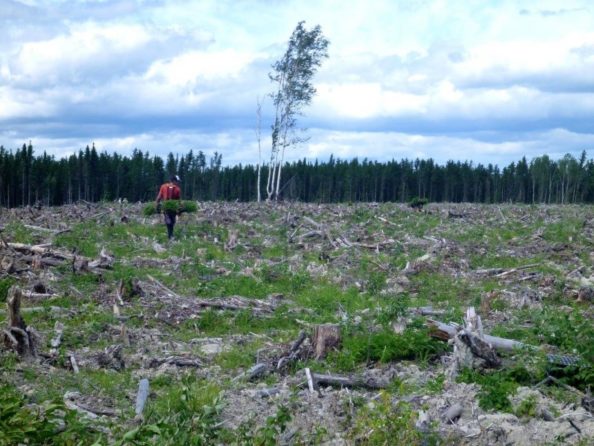 Semi-mechanized pre-commercial thinning
Semi-mechanized pre-commercial thinning
Pre-commercial thinning (PCT) using brush cutters is demanding and costly, particularly in very high-density stands. Compounded by a labour shortage, the situation calls for a dire need for mechanized PCT.
It is in this context that FPInnovations carried out semi-mechanized PCT trials in the summer of 2018 on land managed by Gestion Forestière Lacroix in Gaspésie. A 16-tonne eight-wheeled tracked Ponsse Buffalo forwarder reduced stands’ initial density and cut the cost of final brushing treatment. Trials were conducted in a very dense, young stand (an average of 43,371 stems/ha) of balsam fir and white spruce about two metres tall. The goal was a final density of 2,300 free-growing stems/ha.
The operating diagram included a forwarder running between old skid trails (Figure 1). It made one or two passes (loaded or empty) in the regenerated forest with its wheels crushing the stems. To increase the damage caused by the forwarder’s tracks, the second pass was made in the opposite direction. In addition, a 14,986-kg load was added to the forwarder to increase ground pressure and further crush the trees.
 Figure 1. Diagram of the passes made by the forwarder as compared to the old skid trails.
Figure 1. Diagram of the passes made by the forwarder as compared to the old skid trails.
Two one-metre-wide strips were crushed beneath the forwarder’s tracks with each pass, leaving residual trees in the middle of the pass and untreated strips between the trails. The area crushed by the forwarder’s tracked wheels represented 12% of the block’s area, and the old skid trails 27%. The residual strips subsequently underwent a manual brushing treatment.
Results
A double pass was found to be more effective than a single pass for crushing and damaging the stems so that they no longer compete with crop trees. Injury rates were similar, whether the forwarder was loaded or not. Generally, results show that the greater the area treated by the forwarder, the lower the total treatment cost. The challenge is to maximize the mechanically treated area, while leaving enough trees so that brush cutter operators can select enough quality crop trees to reach the final target density.
The direct costs calculated for the various semi-mechanized treatment trials were all less than those of a manual, semi-motorized approach used by brush cutter operators. Lower combined treatment costs translate into direct savings for PCT operations. In addition, given the limited labour pool, the increased productivity of semi-mechanized PCT would make it possible to treat more areas per season with the same workforce. The area treated by brush cutter operators could be increased by 25 to 36%, for a gain of 0.9 to 1.3 hectares per week, per operator. Given the trials’ limited duration, no generalization can be made about the approach’s reliability under all conditions. A proof of concept on a large area would also increase expertise and optimize the contribution of the various phases deployed.
According to silviculture workers, strips requiring treatment were easier to access on trails crushed by the forwarder. They believe that two passes provided better access and that stems crushed into the ruts did not need to be treated. Crushed stems would die and become more compacted during a one- to two-year waiting period prior to brushing operations, making it easier to move about on the site and boosting productivity.
Use of wearable sensors
Wearable sensors have grown in popularity in several sectors because they offer a range of opportunities for efficiency gains. FPInnovations conducted a pilot study to verify their potential application during reforestation activities, particularly for measuring worker productivity and producing maps that locate each seedling. Such an application would be useful to planters and supervisors, by enabling them to quickly identify overlooked areas or spacing issues. It would also make it possible to measure the density of seedlings planted, cover percentage (stocking) as well as worker productivity.
 For testing purposes, the planters wore Garmin GPSMap 62s devices, combined with a strap heart rate monitor and an accelerometer. The GPS and the heart rate monitor gathered location data every second, while the accelerometer provided 25 data points per second to indicate whether or not the planter was bent over. A machine learning algorithm was used to classify the data and predict which tasks a worker was undertaking at any given point in time with high accuracy. A map that approximated seedling locations was produced from the data. The identified “planting spots” closely matched the reported number of planted seedlings by tree planters, yet location accuracy was not verified in the field.
For testing purposes, the planters wore Garmin GPSMap 62s devices, combined with a strap heart rate monitor and an accelerometer. The GPS and the heart rate monitor gathered location data every second, while the accelerometer provided 25 data points per second to indicate whether or not the planter was bent over. A machine learning algorithm was used to classify the data and predict which tasks a worker was undertaking at any given point in time with high accuracy. A map that approximated seedling locations was produced from the data. The identified “planting spots” closely matched the reported number of planted seedlings by tree planters, yet location accuracy was not verified in the field.
While the proof of concept was positive, it did show the limits of using wearable sensors as related to the challenge of processing big datasets and automating analysis. It would be desirable to develop a GIS tool or an application that automates data processing and map production. Motion sensors with electrodes, or, even better, smart clothing, could also be tested.
For more information, please contact Guyta Mercier at guyta.mercier@fpinnovations.ca.




